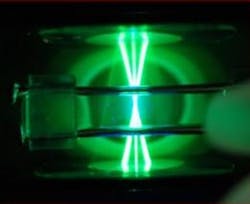Bessel beam allows microscope to look deep into tissue
Freiburg, Germany--Scientists at the University of Freiburg have determined that Bessel beams--known for their "nondiffracting" effects--are not just useful in free space, but can be used in microscopy, too.
Prototype built
Together with his team, Alexander Rohrbach, a professor at the University's Department of Microsystems Engineering, is developing unconventional techniques in microscopy "whose physical concepts are at least as exciting as their technical realization," Rohrbach said. He notes that his team "managed to achieve a direct transfer from basic research to application in the form of a new microscope."
In the forthcoming November issue of Nature Photonics, the scientists describe the microscope, which relies on Bessel beams that reconstruct themselves in light-scattering media. The new method provides insights into the physics of complex light scattering, and enables the device to see about 50% deeper into human skin tissue than with conventional laser beams. The scientists have named their new invention MISERB (microscope with self-reconstructing beams).
Self-reconstructing beams
The Bessel beams are able to self-reconstruct even in the presence of various obstacles, such as a large number of light-scattering biological cells that repeatedly destroy the laser beam's profile. Self-reconstruction works because scattered photons at the center of the beam are replaced by new photons from the side; the photons are nearly in phase even with considerable phases lags from the scattering.
(Back in 2006, Bessel beams that maintain their peak intensity within an absorbing medium were theoretically predicted by researchers at the State University of Campinas in Brazil. However, the simulation did not take scattering into account.)
The scientists used a computer-generated hologram to modify a conventional laser beam into the Bessel beam, whose phase profile has the shape of a cone. Although Bessel beams are known to be so-called "diffraction-free" in free space, it has been completely unclear whether, and to what degree, they are able to regain their original beam shape also in inhomogeneous media, where light scattering is considerable. (It should be noted that a Bessel beam is, in fact, diffracting just as any other beam would; the particular type of diffraction just happens to form a beam that appears unchanged over a certain distance. And in real life, that distance is always finite.)
The researchers hope the new technique will make new biological signal cascades deep inside living organisms more visible than before.
Subscribe now to Laser Focus World magazine; it’s free!

John Wallace | Senior Technical Editor (1998-2022)
John Wallace was with Laser Focus World for nearly 25 years, retiring in late June 2022. He obtained a bachelor's degree in mechanical engineering and physics at Rutgers University and a master's in optical engineering at the University of Rochester. Before becoming an editor, John worked as an engineer at RCA, Exxon, Eastman Kodak, and GCA Corporation.
